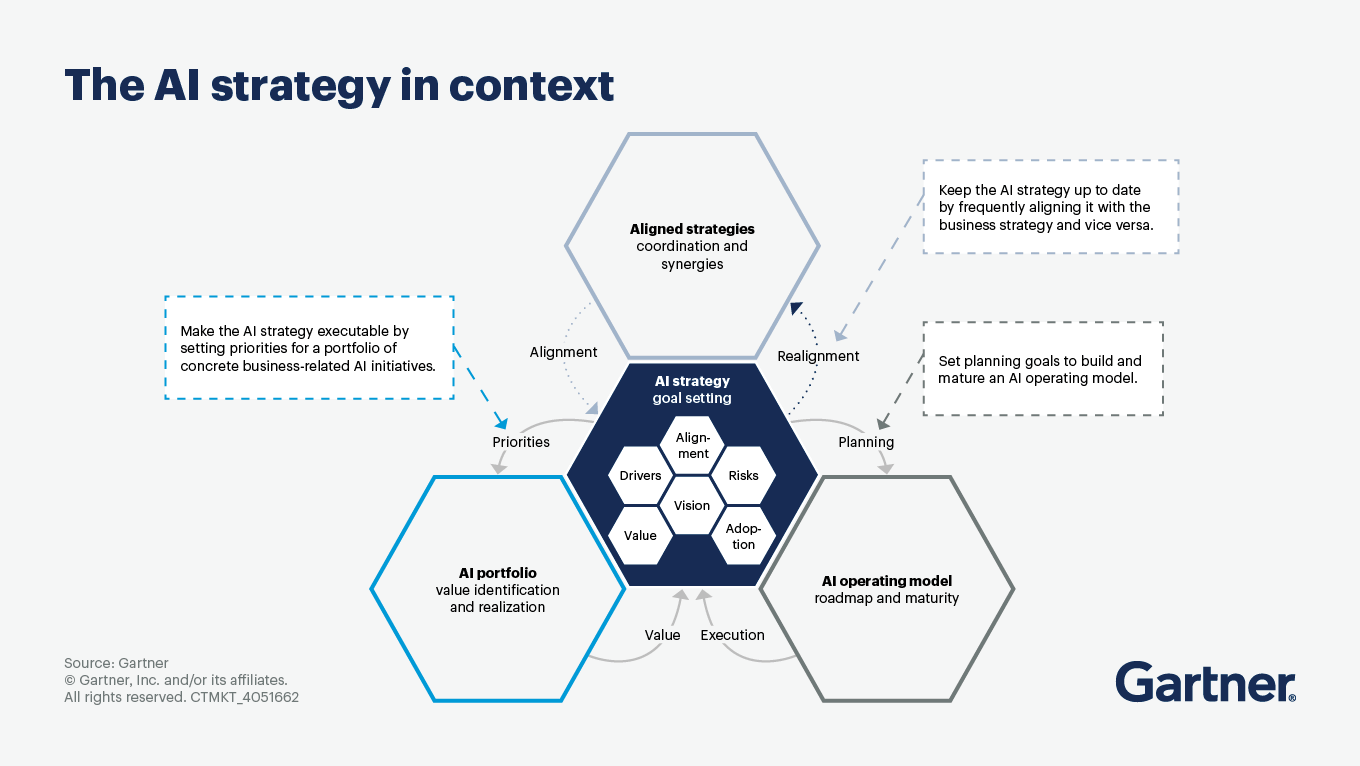Align and realign AI strategy with business strategy — and vice versa — while integrating both your AI portfolio and AI operating model.
- Gartner client? Log in for personalized search results.
Only Good AI Strategy Turns Promise Into Reality. Here’s How to Build One.
By Pieter den Hamer | October 10, 2025
AI strategy can’t be set and frozen — nor seen and executed in isolation
AI has the potential to transform markets, business models and competitive landscapes. To succeed, your AI strategy must be dynamic, evolving alongside your business priorities, market trends and the risk landscape.
More specifically, alignment between AI and business strategy must be bidirectional. Business goals shape your AI agenda, but emerging AI capabilities can — and should — influence business direction. This approach is critical to moving beyond the pedestrian use of AI and realizing its value as a game changer.
Any AI strategy requires key, ever-evolving components
Fully and frequently align AI strategy with business and other enabling technology strategies and ensure an AI portfolio view and adequate AI operating model.
Three essentials of AI strategy
Define your AI vision. Collaborate with your C-Level peers to identify and articulate what you want AI to achieve. Set priorities, ambition, investment levels and adoption targets. Identify where AI will create value and what risks need managing.
Understand drivers and trends. How are they shaping your AI priorities? Consider both AI adoption and impact trends to stay ahead (see Hype Cycle for Artificial Intelligence). Ask how competitors and new entrants are leveraging AI as a catalyst and differentiator for their business and where your organization is vulnerable.
Proactively manage risk. Establish clear principles for responsible, ethical and secure AI use. Identify major risks — beyond compliance and security — and create action plans to mitigate them. Assign clear accountability for AI governance.
Move from AI strategy to execution
A well-crafted AI strategy is only valuable if executed effectively. To execute, you need a plan. Build a robust AI portfolio that tracks all AI use cases and initiatives. Connect this portfolio to your AI roadmap and ensure your AI operating model bridges the gap between current and required capabilities and objectively gauges the readiness of your organization to pursue its AI ambitions effectively.
Key capabilities to assess and develop include:
Objective assessment of your organization’s AI maturity
Data and technology readiness
Governance and organizational structure
AI literacy and engineering skills
The higher your AI ambition, the greater the need for mature capabilities, as well as value and risk management.
Your plan also needs measurable goals and KPIs to gauge progress. Successful execution of the plan will require you to actively manage organizational change, from acquiring and leading AI talent to fostering a culture of innovation around AI.
Continuous realignment of AI strategy is non-negotiable
Business and technology environments are changing fast. Regularly revisit your AI strategy to ensure it remains aligned with business strategy and market realities, as well as key adjacent strategies. Disruptions — whether competitive, technological or regulatory — should trigger a strategic review.
The alignment between AI and other strategies, in particular the business strategy, should be bidirectional. Changes in the corporate strategy, perhaps triggered by new competitive activity or changing market conditions, should be reflected in an updated AI strategy. This should, in turn, result in a reprioritized AI portfolio and updated planning goals for the AI operating model.
Mutual realignment among AI, business and neighboring strategies, such as those for data and analytics and IT, will also mean collaborating with those teams to align on practices and ways of working, which must be agile enough to flex for experimentation and piloting of AI initiatives.
Strategic realignment should also be a periodic but regular item on the agenda of C-Level meetings to ensure corrective actions when necessary.
AI strategy FAQs
What is AI strategy?
AI strategy centers on a vision for what the strategic impact of AI will be on your organization, but it must also prioritize the portfolio of AI initiatives through which actual business value is realized. AI strategy also sets planning goals for your roadmap to develop an AI operating model, including key AI capabilities in terms of technology, data, organization, literacy, engineering and governance.
What are the key steps in developing an AI strategy?
Formulate a vision. Together with C-level stakeholders, identify and formulate a vision for the importance of AI to your organization, given its business goals, current market circumstances and competitor activities.
Determine drivers. What are the key business and technology trends that are driving the priority and planning goals set by the AI strategy?
Identify strategic risks and mitigation plans. What is the organization’s vision for the responsible, ethical and secure use of AI? What are the main risks related to the use of AI in the organization? What are the main action plans to mitigate those risks?
How do I turn my AI strategy into an executable plan?
To turn your AI strategy into a plan, take these actions:
Build and execute your AI roadmap to mature your AI capabilities, based on the AI maturity assessment. This includes key aspects such as governance and risk management, literacy, and data.
Build and deliver business value through your AI portfolio, using the AI strategy goals for use-case prioritization to identify which AI use cases your organization should pursue and with what level of urgency.
Set measurable goals and metrics to monitor and evaluate progress.
Attend a Conference
Accelerate growth with Gartner conferences
Gain exclusive insights on the latest trends, receive one-on-one guidance from a Gartner expert, network with a community of your peers and leave ready to tackle your mission-critical priorities.

Drive stronger performance on your mission-critical priorities.
